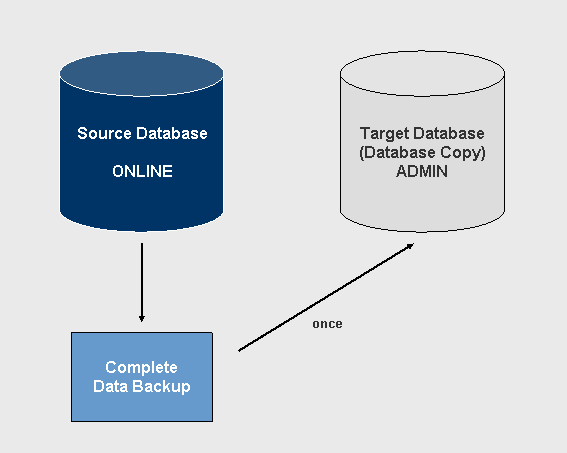 Database Copy
Database Copy 
You can use database copies to test new applications, to check database structures without affecting operation or to set up standby databases. You also need a database copy to create a system copy of an SAP system.
Prerequisites
Source and target computers are compatible.
The data carriers used for generating the database copy are compatible.
In SAP liveCache systems, both the processor architectures and the operating systems of the source and target computer are identical, and the same database procedures are used on both computers.
Compatible Processor Architectures for Database Copies IA32 32bit (all operating systems)
IA64 64bit (all operating systems apart from HP-UX)
x64 64bit (all operating systems)
AIX 64bit
Solaris on -SPARC 64bit
Linux on Power 64bit
HP-UX on IA64 64bit (HP_IPF)
HP-UX on PA-RISC 64bit
IA32 32bit (all operating systems)
x
x
x
IA64 64bit (all operating systems apart from HP-UX)
x
x
x
x64 64bit (all operating systems)
x
x
x
AIX 64bit
x
x
x
x
x
Solaris on SPARC 64bit
x
x
x
x
x
Linux on Power 64bit
x
x
x
x
x
HP-UX on IA64 64bit (HP_IPF)
x
x
x
x
x
HP-UX on PA-RISC 64bit
x
x
x
x
x
 Note
NoteTo execute a database copy on a non compatible processor architecture, use the Loader database tool.
More information: Loader documentation
End of the note.The target database uses the same version of the database software as the source database.
You can, however, use a copy of a source database of an older version as a target database of a more recent version, as long as the versions only differ by build number.
 Example
ExampleVersion of the source database: 7.6.00.09
Version of the target database: 7.6.00.12
End of the example.The database parameters of the target database were defined with the same values as those of the source database, but each database has its own working directory.
Procedure

Database Copy
Create a complete data backup of the source database.
More information: Database Studio, Backing Up Data
Either create a new database or initialize an existing database.
Define the same values for the database parameters in the target database as in the source database (exception: run directory of the database).
More information: Database Studio,
In the target database, create a backup template for a data backup that refers to the data carrier on which you backed up the source database.
More information: Database Studio, Creating Backup Templates
Import the complete data backup into the target database and transfer it to operating state ONLINE.
 Caution
CautionAny existing database user data in the target database is overwritten with the database user data from the source database.
End of the caution.More information: Database Studio, Restoring Databases
More Information
Glossary, System Copy
SAP Note 129352 (Homogeneous System Copy with MaxDB)
SAP Note 1014782 (FAQ: MaxDB System Copy)